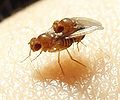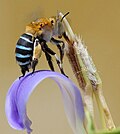Coevolution
Coevolution is a biological concept that refers to the mutual evolutionary influence between two species that interact directly with each other. Each species in a coevolutionary relationship exerts selective pressures on the other, thereby affecting each other's evolution. Coevolution can result in various forms of relationships such as predator-prey, parasite-host, and mutualism, where both species benefit from the interaction.
Mechanisms of Coevolution[edit]
Coevolution occurs through a variety of mechanisms. One common mechanism is through the evolutionary arms race, where predators and prey or parasites and hosts evolve new adaptations and counter-adaptations against each other. Another mechanism is mutualistic coevolution, where species evolve traits that benefit each other.
Gene-for-Gene Coevolution[edit]
In a gene-for-gene relationship, the resistance of the host to a parasite and the ability of the parasite to infect the host are both controlled by specific genes. This type of coevolution is common in the interactions between plants and their pathogens.
Examples of Coevolution[edit]
One of the most famous examples of coevolution is the relationship between flowering plants and their pollinators. Flowers have evolved colors, shapes, and scents that attract specific pollinators, while pollinators have evolved structures and behaviors that enable them to access the nectar and pollen of the flowers they pollinate.
Another example is the coevolution between predators and their prey. For instance, the evolution of camouflage in prey species is a response to the visual hunting strategies of predators. Conversely, predators have evolved more acute senses to detect their prey.
Implications of Coevolution[edit]
Coevolution has significant implications for the biodiversity and stability of ecosystems. It drives the diversity of life by promoting a variety of adaptations and counter-adaptations. Additionally, coevolutionary relationships can influence the distribution and abundance of species within ecosystems.
Coevolution also has practical implications for humans, especially in agriculture and medicine. Understanding coevolutionary relationships can help in the development of sustainable agricultural practices and the management of drug resistance in pathogens.
See Also[edit]
References[edit]
<references/>

-
Coevolution
-
Coevolution
-
Coevolution
-
Coevolution
-
Coevolution
-
Coevolution
-
Coevolution
-
Coevolution
-
Coevolution
-
Coevolution
Ad. Transform your life with W8MD's Budget GLP-1 injections from $75


W8MD offers a medical weight loss program to lose weight in Philadelphia. Our physician-supervised medical weight loss provides:
- Weight loss injections in NYC (generic and brand names):
- Zepbound / Mounjaro, Wegovy / Ozempic, Saxenda
- Most insurances accepted or discounted self-pay rates. We will obtain insurance prior authorizations if needed.
- Generic GLP1 weight loss injections from $75 for the starting dose.
- Also offer prescription weight loss medications including Phentermine, Qsymia, Diethylpropion, Contrave etc.
NYC weight loss doctor appointmentsNYC weight loss doctor appointments
Start your NYC weight loss journey today at our NYC medical weight loss and Philadelphia medical weight loss clinics.
- Call 718-946-5500 to lose weight in NYC or for medical weight loss in Philadelphia 215-676-2334.
- Tags:NYC medical weight loss, Philadelphia lose weight Zepbound NYC, Budget GLP1 weight loss injections, Wegovy Philadelphia, Wegovy NYC, Philadelphia medical weight loss, Brookly weight loss and Wegovy NYC
|
WikiMD's Wellness Encyclopedia |
| Let Food Be Thy Medicine Medicine Thy Food - Hippocrates |
Medical Disclaimer: WikiMD is not a substitute for professional medical advice. The information on WikiMD is provided as an information resource only, may be incorrect, outdated or misleading, and is not to be used or relied on for any diagnostic or treatment purposes. Please consult your health care provider before making any healthcare decisions or for guidance about a specific medical condition. WikiMD expressly disclaims responsibility, and shall have no liability, for any damages, loss, injury, or liability whatsoever suffered as a result of your reliance on the information contained in this site. By visiting this site you agree to the foregoing terms and conditions, which may from time to time be changed or supplemented by WikiMD. If you do not agree to the foregoing terms and conditions, you should not enter or use this site. See full disclaimer.
Credits:Most images are courtesy of Wikimedia commons, and templates, categories Wikipedia, licensed under CC BY SA or similar.
Translate this page: - East Asian
中文,
日本,
한국어,
South Asian
हिन्दी,
தமிழ்,
తెలుగు,
Urdu,
ಕನ್ನಡ,
Southeast Asian
Indonesian,
Vietnamese,
Thai,
မြန်မာဘာသာ,
বাংলা
European
español,
Deutsch,
français,
Greek,
português do Brasil,
polski,
română,
русский,
Nederlands,
norsk,
svenska,
suomi,
Italian
Middle Eastern & African
عربى,
Turkish,
Persian,
Hebrew,
Afrikaans,
isiZulu,
Kiswahili,
Other
Bulgarian,
Hungarian,
Czech,
Swedish,
മലയാളം,
मराठी,
ਪੰਜਾਬੀ,
ગુજરાતી,
Portuguese,
Ukrainian






